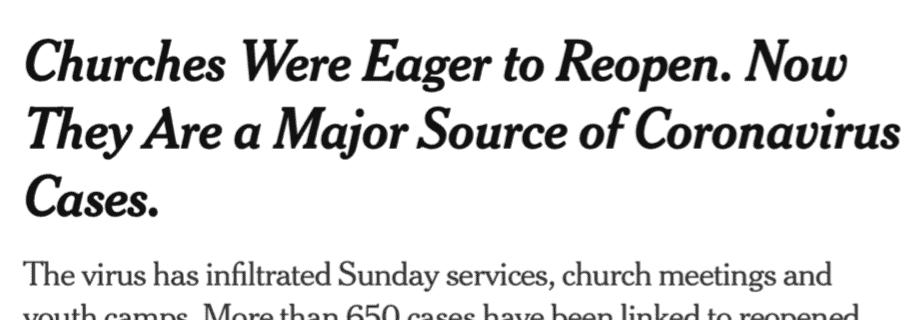The New York Times recently ran a column headlined “Churches Were Eager to Reopen. Now They Are a Major Source of Coronavirus Cases.” The lede is alarming: “The virus has infiltrated Sunday services, church meetings and youth camps. More than 650 cases have been linked to reopened religious facilities.” Here’s how the story begins:
Weeks after President Trump demanded that America’s shuttered houses of worship be allowed to reopen, new outbreaks of the coronavirus are surging through churches across the country where services have resumed.
The virus has infiltrated Sunday sermons, meetings of ministers and Christian youth camps in Colorado and Missouri. It has struck churches that reopened cautiously with face masks and social distancing in the pews, as well as some that defied lockdowns and refused to heed new limits on numbers of worshipers. …
More than 650 coronavirus cases have been linked to nearly 40 churches and religious events across the United States since the beginning of the pandemic, with many of them erupting over the last month as Americans resumed their pre-pandemic activities, according to a New York Times database.
The article, which also made its way to the front page of the Drudge Report and various other aggregator sites, employs a lot of evocative language: Outbreaks are surging; the virus has infiltrated; cases have erupted; and so on. While it affirms that many churches and ministries have created and followed strict guidelines related to masking, social distancing, and other practices, it focuses primarily on churches that “have remained defiant in the face of rising infections.” It tells of Graystone Baptist Church in Ronceverte, West Virginia which made masks optional and saw 51 cases traced back to it; of Lighthouse United Pentecostal Church in Union County, Oregon, which is responsible for “many” of the 356 local cases; of Kanakuk Kamps in Missouri which has had 80 cases traced back to it; and of Calvary Chapel of San Antonio whose pastor inviting his parishioners to begin hugging one another and quickly saw around 50 members get sick.
It all sounds very alarming, but does the Times make its case that churches are a major source of infections? Not even close. Since the early days of the pandemic it has been tracking coronavirus cases in the U.S. and across the world. Its meter, which is currently increasing by around 60,000 per day, has America at “3.0 million+” total cases. A little math shows that, even according to their own numbers, churches represent just the tiniest sliver of that total—roughly .02 percent. It’s hard to know how many churches there are in the U.S., but it could be around 350,000. The 650 cases the Times researched trace back to “nearly 40” of them—only 40 out of 350,000 (or more than 350,000 if we include camps and other ministries, as the article did). So no, the Times does not make the case that churches are a major source of coronavirus cases. If I have $3,000,000 in the bank and you give me another $650, you’d hardly be in the position to claim that you had made a major contribution to my wealth. Similarly, adding 650 cases to America’s total caseload of 3 million is no more than a blip that leaves 99.98% attributable to other causes.
Of course churches should still be cautious, especially as infections surge in certain parts of the country. Even if the Times doesn’t make its case that churches are a major contributor, it does prove that reporters are watching churches and eager to report on their failures, no matter how statistically insignificant. And infectious-disease expert Carlos del Rio, quoted in the article, is not wrong when he points out that churches may just represent “an ideal setting for transmission,” because “you have a lot of people in a closed space.” But Christians know this, which is why churches have been taking precautions, and why they are wise to continue them and to learn from congregations that have shared their experiences with outbreaks.
It seems clear to me that the Times has dramatically over-stated the degree to which churches have contributed to this pandemic. Are there any other .02 percent contributors the Times is covering as “major sources” of coronavirus cases? Not likely! And in their melodramatic alarmism they have missed the true story of churches and the coronavirus.
The true story of churches and coronavirus is the willingness of Christians to go above and beyond.
The true story of churches and coronavirus is their willingness to shutter their services for a time; to move online; to create and implement health and safety guidelines; to open with caution; to reduce seating capacity; to modify elements of their services; even to adhere to guidelines that are stricter for churches than for other sectors or industries. Kristen K. Waggoner of the Alliance Defending Freedom says rightly that “a vast majority of churches meet or exceed federal health guidelines for reopening.” The true story of churches and coronavirus is the willingness of Christians to go above and beyond. Across America and across the world, Christians are doing their utmost to express love to God by worshipping him while also expressing love to their fellow man by taking every reasonable precaution. In that way churches are deserving of commendation, not rebuke.










